INTRO
REGION
LINKS
SHOPS
EVENTS
|
|
HOME INTRO |
VISIT REGION |
MEDIA LINKS |
TOUR SHOPS |
NEWS EVENTS |
|---|---|---|---|---|---|
EBT 1999 Opening / FEBT Summer Celebration 1999 | |||||
< Back to the EBTRR Homepage
< Back to the EBTRR Multimedia Archive
Page Contents:
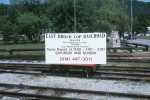 A nice new sign telling of the dates and times of train operations strapped to a vintage
EBT MOW trailer graces the track next to Orbisonia Station.
Across the tracks is the marker for a time capsule planted in the early 1960's.
A nice new sign telling of the dates and times of train operations strapped to a vintage
EBT MOW trailer graces the track next to Orbisonia Station.
Across the tracks is the marker for a time capsule planted in the early 1960's.
 Beneath the south arch of the Aughwick Bridge sun
and water cast mysterious reflections on the concrete. This is the underside of the
southmost arch. The shimmering light pattern is a result of the right combination of
light and wind playing on the water.
Beneath the south arch of the Aughwick Bridge sun
and water cast mysterious reflections on the concrete. This is the underside of the
southmost arch. The shimmering light pattern is a result of the right combination of
light and wind playing on the water.
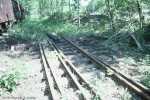 In Mount Union, the switch at the junction of
the main and the enginehouse spur receives new ties.
In Mount Union, the switch at the junction of
the main and the enginehouse spur receives new ties.
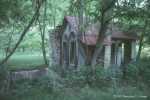 Above Three Springs on the side of Jacks Mountain,
NARCo the ganister quarry serviced by the EBT remains. Here is the scale house used to
weigh the rock before sending it to the crusher then to the tipple for shipment. The
scale resided in the pit to the left of the building.
Above Three Springs on the side of Jacks Mountain,
NARCo the ganister quarry serviced by the EBT remains. Here is the scale house used to
weigh the rock before sending it to the crusher then to the tipple for shipment. The
scale resided in the pit to the left of the building.
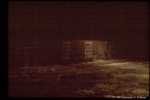 In the Rockhill Furnace Yard an attempt at long
exposure photography at the Carpentry Shop yields
lackluster results. These are the spare locomotive tires leaning against the shop building.
In the Rockhill Furnace Yard an attempt at long
exposure photography at the Carpentry Shop yields
lackluster results. These are the spare locomotive tires leaning against the shop building.
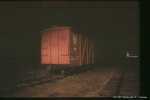 Another time exposure, this time of boxcar 181 with the passing cars on Meadow Street
leaving light streaks in the distance.
Another time exposure, this time of boxcar 181 with the passing cars on Meadow Street
leaving light streaks in the distance.
 #181 again with the faint outline of the Boiler
House in the background.
#181 again with the faint outline of the Boiler
House in the background.
 A bright and clear day marks the beginning of the 1999 season at Old Easty. In Rockhill, the
Shops Office observes the commencement of operations.
A bright and clear day marks the beginning of the 1999 season at Old Easty. In Rockhill, the
Shops Office observes the commencement of operations.
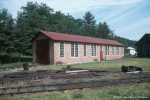 Across the escape track, the Paint Shop keeps an eye
on the Shops Office. Today it houses M-3,
M-4, occasionally M-6 and the unfinished Aughwick coach.
Across the escape track, the Paint Shop keeps an eye
on the Shops Office. Today it houses M-3,
M-4, occasionally M-6 and the unfinished Aughwick coach.
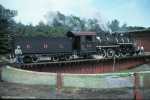 #14 steps into the light to perform the honors for the day. She has just been aligned
with the turntable lead.
#14 steps into the light to perform the honors for the day. She has just been aligned
with the turntable lead.
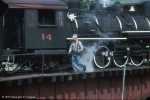 #14 belongs, as usual, to engineer Tom Holder this run. He is ready to take her
off the turntable.
#14 belongs, as usual, to engineer Tom Holder this run. He is ready to take her
off the turntable.
 A closeup of #14 at Colgate Grove shows her Hancock Inspirator Type A injector
and Pyle National dynamo.
A closeup of #14 at Colgate Grove shows her Hancock Inspirator Type A injector
and Pyle National dynamo.
 To the surprise of all, M-1 ventured out to stretch her legs after a long winter's nap.
She received some work to ready her for her limited runs during the season.
To the surprise of all, M-1 ventured out to stretch her legs after a long winter's nap.
She received some work to ready her for her limited runs during the season.
 At the beginning of the FEBT shops tour, M-1 has returned to her stall in the
Roundhouse.
At the beginning of the FEBT shops tour, M-1 has returned to her stall in the
Roundhouse.
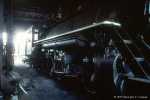 #17 receives work for the upcoming Fall Spectacular where she will make her yearly
appearance.
#17 receives work for the upcoming Fall Spectacular where she will make her yearly
appearance.
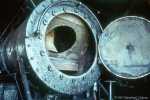 #12's smokebox door hangs open as if in the midst of a yawn after a long nap. Inside,
the cinder catching screen is revealed. The screen is intended to catch most of the
larger cinders before they go up the stack and cause brush fires. The funnel that
leads the stack (called the petticoat) is visible inside.
#12's smokebox door hangs open as if in the midst of a yawn after a long nap. Inside,
the cinder catching screen is revealed. The screen is intended to catch most of the
larger cinders before they go up the stack and cause brush fires. The funnel that
leads the stack (called the petticoat) is visible inside.
 Cold for 44 years, #18 waits for a call to duty. She has made rare
excursions outside the roundhouse for display.
Cold for 44 years, #18 waits for a call to duty. She has made rare
excursions outside the roundhouse for display.
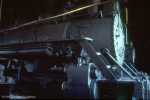 Beside #18, #16 similarly awaits her call as well. She was reportedly rebuilt
not long after the end of regular operations.
Beside #18, #16 similarly awaits her call as well. She was reportedly rebuilt
not long after the end of regular operations.
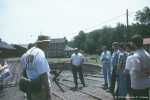 After the Roundhouse, the group pauses to hear a
few words from EBT General Manager Stanley Hall.
After the Roundhouse, the group pauses to hear a
few words from EBT General Manager Stanley Hall.
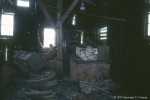 Inside the Blacksmiths Shop spare locomotive
springs litter the floor near one of the many forges here.
Inside the Blacksmiths Shop spare locomotive
springs litter the floor near one of the many forges here.
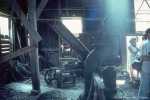 A belt driven reciprocating saw glistens in
the windows. It is belt driven from a shaft in the Machine Shop, as is
the hammer beside it.
A belt driven reciprocating saw glistens in
the windows. It is belt driven from a shaft in the Machine Shop, as is
the hammer beside it.
 They don't call it the Blacksmiths Shop for nothing.
This standard Blacksmith's Forge awaits its next use.
They don't call it the Blacksmiths Shop for nothing.
This standard Blacksmith's Forge awaits its next use.
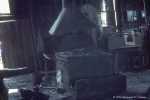 Here are two more of the four forges in the building. In the front is another
Blacksmith's Forge and behind is
a specialized Flue Forge.
Here are two more of the four forges in the building. In the front is another
Blacksmith's Forge and behind is
a specialized Flue Forge.
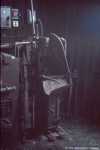 This curious contraption is a Locomotive Flue
Hammer and is still used to shape and heat weld locomotive flues.
This curious contraption is a Locomotive Flue
Hammer and is still used to shape and heat weld locomotive flues.
 This is a closeup of the Flue Forge used in
conjunction with the Locomotive Flue
Hammer.
This is a closeup of the Flue Forge used in
conjunction with the Locomotive Flue
Hammer.
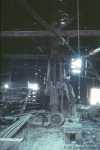 Dominating the building's interior is this large
Steam Hammer.
Dominating the building's interior is this large
Steam Hammer.
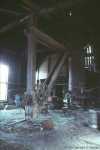 Now in the Foundry, the
cupola furnace and
gantry are the largest items.
Now in the Foundry, the
cupola furnace and
gantry are the largest items.
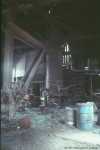 Here's a better shot of the furnace.
To the right is a small wall mounted gantry used for the smaller
brass furnace.
Here's a better shot of the furnace.
To the right is a small wall mounted gantry used for the smaller
brass furnace.
 In the Car Shop this is the
electric motor and pump that keeps the water
flowing to EBT locos by topping off the
Reservoir Ponds.
In the Car Shop this is the
electric motor and pump that keeps the water
flowing to EBT locos by topping off the
Reservoir Ponds.
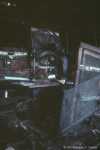 Also in the Car Shop, here is a belt driven
band saw.
Also in the Car Shop, here is a belt driven
band saw.
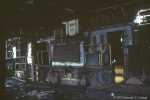 This large Davenport switcher has been sitting in the
Car Shop for some time.
It is believed to have come to the property with M-6. Since it has only two axles
it would be very hard on the track. That and the fact that it is cabless likely keeps it
out of service.
This large Davenport switcher has been sitting in the
Car Shop for some time.
It is believed to have come to the property with M-6. Since it has only two axles
it would be very hard on the track. That and the fact that it is cabless likely keeps it
out of service.
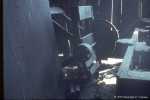 .
This belt driven circular saw lies
at the end of the building where there are no overhead lines. It's original
location is not known.
.
This belt driven circular saw lies
at the end of the building where there are no overhead lines. It's original
location is not known.
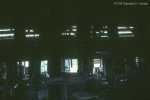 .
In this rather dark picture you can just make out the
Chop Saw table in the middle.
.
In this rather dark picture you can just make out the
Chop Saw table in the middle.
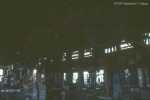 This shot shows the Davenport switcher and a
planer in the foreground.
This shot shows the Davenport switcher and a
planer in the foreground.
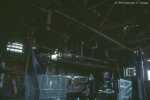 To the left is a drill press and to the right
is the band saw. Some of the overhead lines are visible.
To the left is a drill press and to the right
is the band saw. Some of the overhead lines are visible.
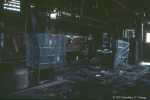 This photo is the same as the previous shot, just with a better view of the machines.
This photo is the same as the previous shot, just with a better view of the machines.
 .
Although it's hard to see, there is a
planer/shaper in this shot.
.
Although it's hard to see, there is a
planer/shaper in this shot.
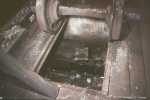 .
Here is the transverse jack used to
lower driving wheel sets off of locomotives. The jack was restored in 1987
when #14 was rebuilt here.
.
Here is the transverse jack used to
lower driving wheel sets off of locomotives. The jack was restored in 1987
when #14 was rebuilt here.
 .
Out of the shops now, this is the interior of
Saltillo Station. You can see the ticket window and the deplorable condition of the roof.
.
Out of the shops now, this is the interior of
Saltillo Station. You can see the ticket window and the deplorable condition of the roof.
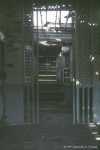 .
This is the interior of the bay window. Little roof remains.
.
This is the interior of the bay window. Little roof remains.
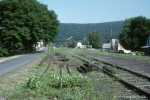 North of the Mount Union Yard preparations are underway
to reconnect the EBT main (left) to the old Pennsy spur (right).
North of the Mount Union Yard preparations are underway
to reconnect the EBT main (left) to the old Pennsy spur (right).
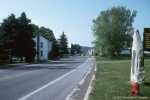 The little borough of Shirleysburg was once served
by the EBT and current operations end just south of here.
The little borough of Shirleysburg was once served
by the EBT and current operations end just south of here.
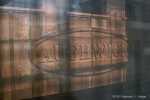 Inside the Paint Shop the unfinished steel framed coach,
the "Aughwick", rests. It is built on the frame of an old D&RGW flatcar that was later converted
into a passenger car for use in an amusement park.
Inside the Paint Shop the unfinished steel framed coach,
the "Aughwick", rests. It is built on the frame of an old D&RGW flatcar that was later converted
into a passenger car for use in an amusement park.
 At the south end of the yard the Section House and
Handcar Shed slowly ebb to the ravages of the elements.
At the south end of the yard the Section House and
Handcar Shed slowly ebb to the ravages of the elements.
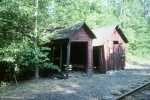 This is a vew of the same two buildings from the south. The ailment of the
Handcar Shed is especially apparent.
This is a vew of the same two buildings from the south. The ailment of the
Handcar Shed is especially apparent.
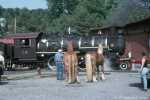 Horsepower versus horsepower as the iron horse meets its flesh-and-blood counterpart.
The latter was less than pleased with the gasps and toots of the former.
Horsepower versus horsepower as the iron horse meets its flesh-and-blood counterpart.
The latter was less than pleased with the gasps and toots of the former.
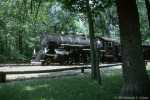 #14 rests leisurely at Colgate Grove, awaiting
departure time.
#14 rests leisurely at Colgate Grove, awaiting
departure time.
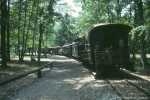 The excursion train waits behind #14 with the parlor car Orbisonia bringing up the rear.
The excursion train waits behind #14 with the parlor car Orbisonia bringing up the rear.
 Looking out the rear of the Orbisonia parlor car we see the end
of the operating railroad in the brush south of
Rockhill Furnace.
Looking out the rear of the Orbisonia parlor car we see the end
of the operating railroad in the brush south of
Rockhill Furnace.
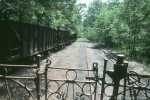 Rusty hoppers on the sidings of Rochill await the next load of coal that will never come.
Rusty hoppers on the sidings of Rochill await the next load of coal that will never come.
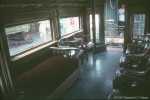 The interior of the Orbisonia has received new leather furniture for the 1999 season.
The original wicker furniture used in the car was badly worn and was removed for safe keeping.
The interior of the Orbisonia has received new leather furniture for the 1999 season.
The original wicker furniture used in the car was badly worn and was removed for safe keeping.
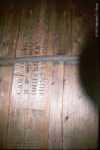 Inside Coles Tankhouse the side of the tank is marked for its maker.
Inside Coles Tankhouse the side of the tank is marked for its maker.
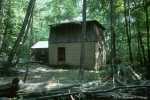 Deep in the forests of the Alleghenies, Coles Tankhouse
defies the elements while awaiting the next train which is 44 years overdue.
Deep in the forests of the Alleghenies, Coles Tankhouse
defies the elements while awaiting the next train which is 44 years overdue.
|
HOME |
The East Broad Top Railroad Homepage © 1994-2005 Christopher D. Coleman All rights reserved Site Information Top of this page |
|---|